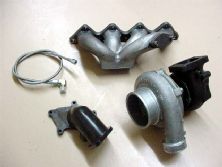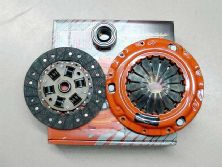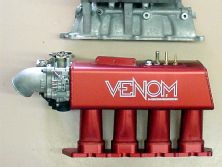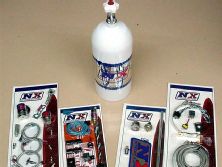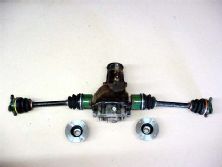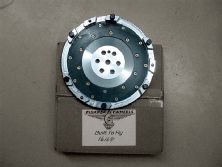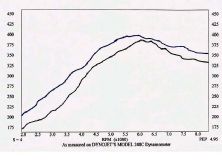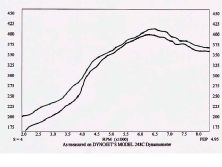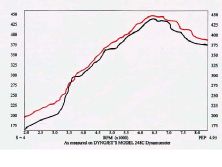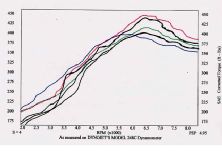It's time to step up in the turbo department. So far, the 4G63 in Doug's Dynopower's Galant VR-4 has performed admirably and made impressive numbers through the first four installments of this "Dyno Cell" saga.
Most of the time, enthusiasts go big and expect a bigger turbo to deliver the big power numbers on its own. However, most don't understand the relationship between components plays a role in making an engine run well. A huge Garrett turbo is great for power potential, but without the supporting hardware and tuning, it just looks pretty.
Another issue with Garrett turbos is there are so many choices. Unlike Mitsubishi turbochargers, which are only available in specific sizes, Garrett turbos can span many "families" as hybrids. Further, there are more wheel and housing choices on the Garrett side. To novices, this can complicate things. But for knowledgeable enthusiasts and tuners, these choices mean a much more optimized turbo can be selected.
The most popular Garrett unit for the 4G63 is the T3/T4 hybrid, especially since a new cast-iron manifold complete with an external wastegate port is now offered for these engines. This set-up uses a custom O2 housing that adapts to the car's downpipe.
Doug's Dynopower (DDP) tried three different units on the Galant before deciding on the one currently in use. Doug's Dynopower used its own Stage 1, 2 and 3 versions it offers in kit configuration. For our article, Doug's Dynopower (DDP) bolted on its Stage 2 turbo.
The first thing noticed at Doug's Dynopower was slower boost response compared with the 16g. In this case, the company opted for the ball-bearing option to promote a faster spool-up and increase the durability of the turbo's bearing cartridge. Whereas the 16g would be boosting well past 10 psi at 2800 rpm, the Garrett is at a leisurely 5 psi.
However, the difference in airflow is so substantial that 5 psi from the Garrett moves the car along as well as, if not better than, 10 psi did with the previous system-the previous pressure vs. volume axiom.
Another point of interest is the wastegate. An external gate keeps more precise control of the boost level, and only opens when it needs to do its job. An internal or integral gate tends to open with the exhaust pressure in the turbine housing, which slows boost response.
The T3/T4 hybrid turbo and its external wastegate were installed and the car was driven on the street for some time to tune the fuel system and timing. Then it was time to dyno the new combination. Starting at 15 psi, the 4G63 pumped out more than 355 hp. In comparison, the 16g had to be at 19 psi to make numbers in the 340-hp range.
Upping the Garrett to 18 psi netted 378.1 hp and 391.7 lb-ft of torque. While low-end power and torque fell off slightly, the engine revved more quickly with the Garrett on the job. So much so that the stock rev limiter was hit much too easily. Luckily, DDP had a TMO-tuned ECU in the car with an 8500 rev limit for this test.
Driving the car is a night-and-day difference when compared with a stock car or one with a smaller upgraded turbo. The power is smooth with the T3/T4, lacking a surge or spike of torque between 3500 to 4000 rpm. Instead, the engine pulls seamlessly to 7500 rpm and above.
Since the engine is ingesting a great deal more air, testing a higher flowing intake manifold should reap benefits. A Venom unit was selected because of its build quality and reasonable fitment. On the 4G63, this manifold is not an R&R install. The stock coil needed to be moved and a bracket fabricated. An intercooler pipe had to be moved as well.
Now you'd think low-rpm response and power would suffer with the intake installed. However, this was not the case. Once the engine reached 4000 rpm, it would shoot to 7000-plus rapidly when accelerating under boost. Basically, it behaved like a motorcycle engine. Top-end power was different as well. The engine didn't have a bottleneck at higher engine speeds, which normally results in a drop-off on the power curve. Instead, the 4G63 would pull very hard until you let off. The torque curve was fairly flat in the mid-range and increased sizably above 7000 rpm.
With boost still set at 18 psi, peak output increased to a best of 397.3 hp and 412.8 lb-ft of torque. The Crower cams from the last installment complement the intake manifold and turbo set-up. They all scream "mega-flow" and are further testimony to the importance of properly matched parts.
Nitrous oxide, the chemical supercharger, is a popular avenue for enthusiasts on a budget or those with non-mainstream vehicles that lack the aftermarket support Honda gets. In the ranks of some enthusiasts, most notably Supra and Buick Grand National fans, adding nitrous to a turbocharged car can be seen as akin to cheating. Some will be more accepting of nitrous in the form of a spool-up system designed to come on at WOT and shut off at a pre-described boost level.
An oft-overlooked byproduct of a nitrous system is the cooling effect the gas has on the incoming charge air. Plus, the stuff makes power. Doug's Dynopower wanted more power and beyond upping the boost, nitrous was pretty much the last option left. A single-nozzle set-up from Nitrous Express was plumbing into the 4G63.
Beyond the expected parts, the Nitrous Express kit included a bottle heater, gauge and purge valve and a "low fuel pressure" shut-off switch. Installation was straightforward and Doug's Dynopower used a mild 35-hp jetting strategy. The 4G63 engine responds well to laughing gas, especially in small doses. With no other changes, the engine generated 436.7 hp and 447.6 lb-ft of torque while on the squeeze.
Prior to any of the Part 5 add-ons, the clutch on the car was swapped. It had a tendency to slip with the 16g and Doug's Dynopower knew an upgraded turbo and adding the juice would push it too far. Doug's Dynopower installed a new Centerforce Dual-Friction clutch along with a Fidenza aluminum flywheel and logged 500 miles of break-in time before dynoing the Garrett turbo system.
The 4G63 DSMs are among the most eager cars in the sport compact scene. It's no secret the potential of the engine easily out-distances the potential of the driveline. The clutch is like a fuse; it's designed to give out in lieu of any hard parts in the driveline. As the clutch's capacity is increased, the impact on the driveline is increased. The trick is getting a clutch strong enough to put the power down, yet not break transmissions, transfer cases, axles, rear differentials and so on.
When addressing the clutch, it's good to consider a lightened flywheel. Impressed with the materials and quality of the new Fidenza units, Doug's Dynopower just had to try one. Unfortunately, Doug's Dynopower never made separate dyno runs with the clutch/stock flywheel and clutch/Fidenza combo. The new unit is vastly lighter than the stocker by more than 10 lbs and Doug's Dynopower could tell the engine revved quicker with it.
For now, the stock transmission is holding up fine. Doug's Dynopower intends to get it rebuilt with stronger shift forks, synchros, and a four-spider-gear center differential.
The only other weak link is the rear differential and axles. The Galant comes with a three-bolt rear end. The axle caps are attached with three bolts, and the axles are small in diameter. In fact, the axles are smaller than a 1992 to '94 AWD DSM rear end assembly.
The Galant also has four-wheel steering and since the pump is attached to the rear differential on the Galant, Doug's Dynopower opted to remove it all. This resulted in a weight savings of roughly 45 lbs. A decent used four-bolt rear end now sits there and it will stand up better to power and future drag strip testing.
Now what's in the cards for the Galant? Doug's Dynopower will try larger nitrous jets and possibly a larger turbo, along with a ported, SS-valve head. These proposed mods will pretty much exhaust our bolt-on efforts. Stay tuned.
Power Realization Chart Round 1 Modifications HpTqGain HpGain TqBaseline190.6198.2----K&N Filter201.8220.311.222.1DDP Exhaust215.5243.613.723.3DDP Downpipe220.7254.15.210.5Total Gain----30.155.9 Power Realization Chart Round 2 Modifications HpTqGain HpGain TqPrevious Power220.754.1---- Spearco Intercooler251.3286.430.632.3DDP Cat259.9304.18.617.7/td>TeamRip Mass Air271.5302.711.6-14Total Gain----50.848.6 Power Realization Chart Round 3 Modifications HpTq Gain HpGain TqPrevious Power271.5302.7----TD05-16g turbo299.1322.427.619.7APEXi AFC307.2334.68.112.2Turbo XS HPBC319.8348.712.614.1Total Gain----48.346.0 Power Realization Chart Round 4 Modifications16G turbo at 19 psi HpTqGain HpGain TqPrevious Power319.8348.7----RC Injectors327.2354.67.45.9Crower Cams339.3367.812.113.2Crane Ignition342.4371.53.13.7Total Gain----22.622.8 Power Realization Chart Round 5 Modifications HpTq Gain HpGain TqPrevious Power342.4371.5----Garrett T3/T4 (15psi)355.2n/a12.8--Garrett T3/T4 (18psi)378.1391.722.920.2Venom Intake397.3412.819.221.1Nitrous Express436.7447.639.434.8Total Gain----94.376.1 SourcesCenterforce
({{{928}}}) 771-8422
www.centerforce.com
Doug's Dynopower
(702) 616-6081
Fidenza Engineering Corp.
(440) 259-5656
Nitrous Express
({{{940}}}) 767-7694
Python Injection (Venom Racing)
(714) 828-1406


